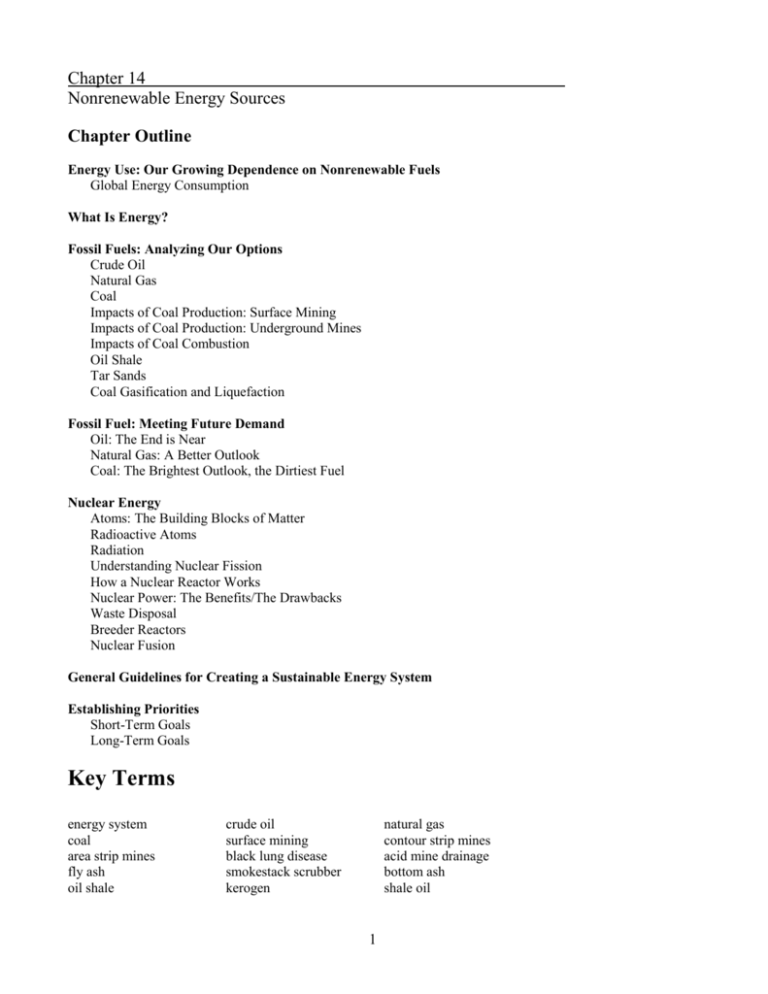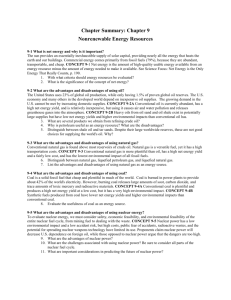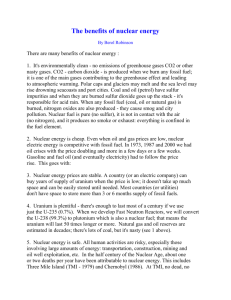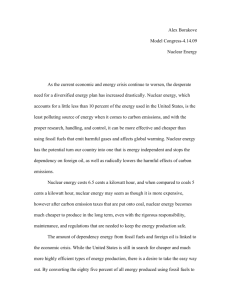Chapter 14 Outline Notes
advertisement

Chapter 14 Nonrenewable Energy Sources Chapter Outline Energy Use: Our Growing Dependence on Nonrenewable Fuels Global Energy Consumption What Is Energy? Fossil Fuels: Analyzing Our Options Crude Oil Natural Gas Coal Impacts of Coal Production: Surface Mining Impacts of Coal Production: Underground Mines Impacts of Coal Combustion Oil Shale Tar Sands Coal Gasification and Liquefaction Fossil Fuel: Meeting Future Demand Oil: The End is Near Natural Gas: A Better Outlook Coal: The Brightest Outlook, the Dirtiest Fuel Nuclear Energy Atoms: The Building Blocks of Matter Radioactive Atoms Radiation Understanding Nuclear Fission How a Nuclear Reactor Works Nuclear Power: The Benefits/The Drawbacks Waste Disposal Breeder Reactors Nuclear Fusion General Guidelines for Creating a Sustainable Energy System Establishing Priorities Short-Term Goals Long-Term Goals Key Terms energy system coal area strip mines fly ash oil shale crude oil surface mining black lung disease smokestack scrubber kerogen natural gas contour strip mines acid mine drainage bottom ash shale oil 1 net energy analysis in situ retorting coal gasification ultimate production nucleus radiation beta particle nuclear fission light water reactors breeder reactor net energy yield tar sands synfuels nuclear energy elements radionuclides gamma rays nuclear fusion fuel rods magnetic confinement surface retort bitumen coal liquefaction atom isotopes alpha particle X-rays daughter nuclei reactor core energy quality Objectives 1. List the major fossil fuels and discuss their environmental impacts. 2. Discuss the availability of fossil fuels in the future. 3. Define the following terms: atom, nucleus, elements, and isotopes. 4. Define the following terms: nuclear fission, nuclear fusion, fuel rods, reactor core, and daughter nuclei. 5. List the different kinds of ionizing radiation. 6. Discuss the advantages and disadvantages of nuclear power. 7. Discuss the different types of nuclear reactors. 8. Discuss the feasibility of using breeder reactors in place of conventional nuclear reactors. 9. List some guidelines for creating a sustainable energy system. 10. Summarize the energy quality of available fuels. Lecture Outline I. Energy Use: Our Growing Dependence on Nonrenewable Fuels A. U.S. Energy Consumption 1. In the past century, wood was our major fuel; today oil, natural gas, and coal provide most of our energy. B. Global Energy Consumption 1. Global Energy Consumption—Renewable fuels provide a significant portion of the energy sources in developing nations, whereas industrialized nations rely principally on nonrenewable energy sources. 2. The United States accounts for 5.6% of the world's population but uses 25% of its energy; sheer wastefulness and inefficiency are partially to blame for this discrepancy. II. What is energy? A. Energy comes in many forms 1. renewable 2. nonrenewable B. Energy can be converted from one form to another C. Energy can neither be created nor destroyed (first law of thermodynamics) 2 D. Energy is degraded when it is converted from one form of energy to another and heat is lost (second law of thermodynamics). E. No energy conversion is 100% efficient. F. Energy is the ability to do work! 1. Fossil Fuel: Analyzing Our Options—The energy system impacts human and ecosystem health at several points: exploration, extraction, processing, distribution, and end use. A. Crude Oil 1. Crude oil provides many useful fuel and nonfuel byproducts. 2. Oil is extracted from deep wells on the seafloor and land. Often, natural gas is found along with oil 3. The major impacts on the environment come from oil spills and from combustion of oil and its derivatives. B. Natural Gas: While not an ideal fuel, natural gas has few environmental impacts compared to other fossil fuels. C. Coal 1. Strip mining and tunnel mining for coal have had considerable environmental impacts on large regions of the United States; impacts include erosion, habitat loss, siltation, acid drainage, and land subsidence. 2. Transporting and burning coal produces a variety of air and water pollution and solid waste pollution problems. D. Oil Shale 3 1. Oil Shale—Oil shale contains kerogen that can be heated to shale oil and refined into petroleum-like products. 2. Though abundant and versatile, shale oil is expensive, inefficient, and causes extreme environmental damage from mining and refining. E. Tar Sands 1. Bitumen in tar sands can be refined into petroleum substitutes; however, it is economically and environmentally costly, and supplies are limited. F. Coal Gasification and Liquefaction 1. Costs, air and water pollution, and net energy inefficiency make coal gasification and liquefaction low-priority energy forms 2. Fossil Fuel: Meeting Future Demands A. Oil: The End Is Near—It appears that oil supplies may only last 20 to 40 years. B. Natural Gas: A Better Outlook—The outlook for natural gas is better than oil with global reserves lasting about 60 years. C. Coal: Coal is the world’s most abundant fossil fuel. The recoverable reserves would last 1700 years at the current rate of consumption. World proven reserves are estimated to last 200 years at the current rate of consumption. IV. Nuclear Energy: Nuclear energy provides a growing percentage of the world’s energy demands. Nuclear Fission produces heat by splitting fissile atoms such as U-235. A. Atoms: The Building Blocks of Matter 1. The atom is composed of two parts: the nucleus and the electron cloud. C. Radioactive Atoms 1. Elements: Elements are the purest form of matter. Not all atoms of each element are identical. All atoms of the same element contain the same number of protons, the positively charged particles in the nucleus. Some atoms of the same element have different numbers of neutrons; these atoms are called isotopes. 2. Excess neutrons in some isotopes make them unstable, and they emit radiation and are called radioactive elements. D. Radiation 1. Radionuclides naturally emit radiation in one of three forms: alpha particles, beta particles, or gamma rays; X-rays are not naturally occurring. 4 2. Ionizing radiation in any of the above forms damages living tissues by creating charged atoms, ions, which are highly reactive. E. Understanding Nuclear Fission 1. Fission: Fission is the splitting of atoms. 2. Nuclear Fission: Inside a nuclear reactor, U-235 atoms undergo fission when they are struck by neutrons. When the atoms split after being struck by the neutrons they release large amounts of energy. F. How a Nuclear Reactor Works 1. Nuclear fuel is extracted from naturally occurring uranium ore. Uranium is a mixture of U-235, which is fissionable, and U-238, which is not. 2. The U-235 fuel must be enriched to a concentration of 3%. This so-called “yellow cake” is then formed into pellets and inserted into fuel rods. The fuel rods are bundled and lowered into the reactor core. 3. The chain reaction in the reactor is controlled by inserting control rods between the fuel rods to dampen the chain reaction. 4. There are four basic types of nuclear reactors used today: a. b. c. d. pressurized boiling-water gas-cooled light-water 5. Pressurized and boiling-water are the most common types used today. G. Nuclear Power: The Benefits 1. Nuclear power does not contribute to the greenhouse effect or acid rain. 2. It requires less surface mining because it requires less fuel material. Transportation costs and environmental impacts are less than those of coal. 5 H. Nuclear Power: The Drawbacks 1. Health Effects of Radiation: The effects of radiation depend to a large extent on the amount, exposure time, and type of radiation. Within a population, individuals in certain developmental stages are most susceptible to damage; similarly, certain cell types within an individual are more vulnerable than others to ionizing radiation 2. Health Impacts of High-Level Radiation—Though variable due to a number of factors, health effects of radiation include death, radiation sickness, and a host of delayed effects, including cancer and sterility. 3. Health Impacts of Low-Level Radiation—Low-level doses are thought to increase cancer and leukemia rates, genetic defects, aging, and perhaps suppress natural immunity. 4. Bioaccumulation: Bioaccumulation refers to the accumulation of radionuclides within tissues and the increasing concentration of those materials at higher trophic levels. 5. Reactor Safety a. Attempts, such as the Rasmussen Report, to statistically assess nuclear power risks are fraught with difficulties and largely discredited today. b. Variables including human error, terrorism, and sabotage make nuclear reactor safety assessment difficult. c. Accidents such as those at Three Mile Island and Chernobyl feed skepticism about industry claims of reactor safety. 6. Waste Disposal a. Radioactive wastes are generated at several points in the fuel cycle; these wastes must be isolated for thousands of years. b. Disposal techniques and repositories for high-level radioactive wastes have not yet been developed despite the continued production of such wastes. 7. Social Acceptability and Cost a. When all planning, construction, licensing, operating, maintenance, and decommissioning costs are factored in, nuclear power is our most expensive energy source today. b. High costs, safety concerns, and mismanagement have combined to lower the social acceptability of nuclear power relative to other energy sources. 8. Proliferation of Nuclear Weapons a. The link between nuclear power and nuclear bombs is well established. I. Breeder Reactors 1. Breeders convert an abundant material (U-238) into plutonium, which can then be extracted to fuel other reactors; thus, breeders can theoretically multiply our nuclear fuel supply. 2. Drawbacks to breeder programs include cost, safety concerns, and plutonium's toxicity and desirability for nuclear weapons and terrorist explosives. I. Nuclear Fusion 1. Nuclear fusion involves combining nuclei of light elements. 2. Numerous technical problems related to the operating design, reactants, and products will delay commercial feasibility by several decades. 6 V. General Guidelines for Creating a Sustainable Energy System A. A sustainable energy future would incorporate the following: positive net energy production, energy matched in quality to the task, maximized efficiency and safety, minimized pollution, abundant and renewable energy sources, and affordability. VI. Establishing Priorities A. Short-Term Goals (within 20 years) 1. Efficiency and renewability must be the major goals of near-term energy planning. B. Long-Term Goals (within 50 years) 1. A renewable replacement for natural gas must be found soon. 2. A new policy for a responsible, sustainable energy program will almost certainly necessitate abandonment of old energy allegiances and customs. Nearby nuclear power plants: http://www.energy.ca.gov/nuclear/california.html 7








